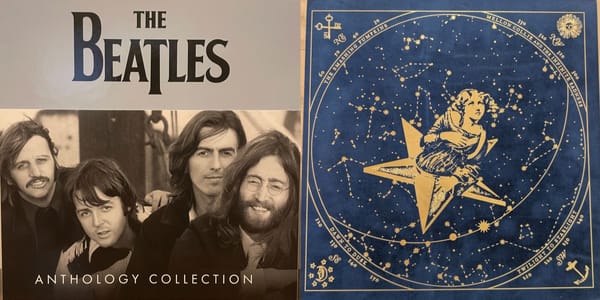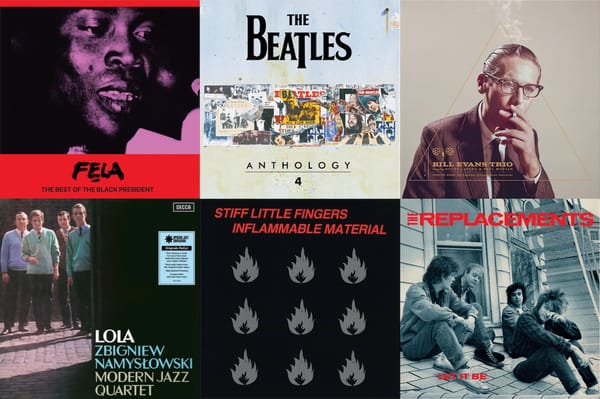Reviews: The Velvet Underground | Sister Irene O’Connor
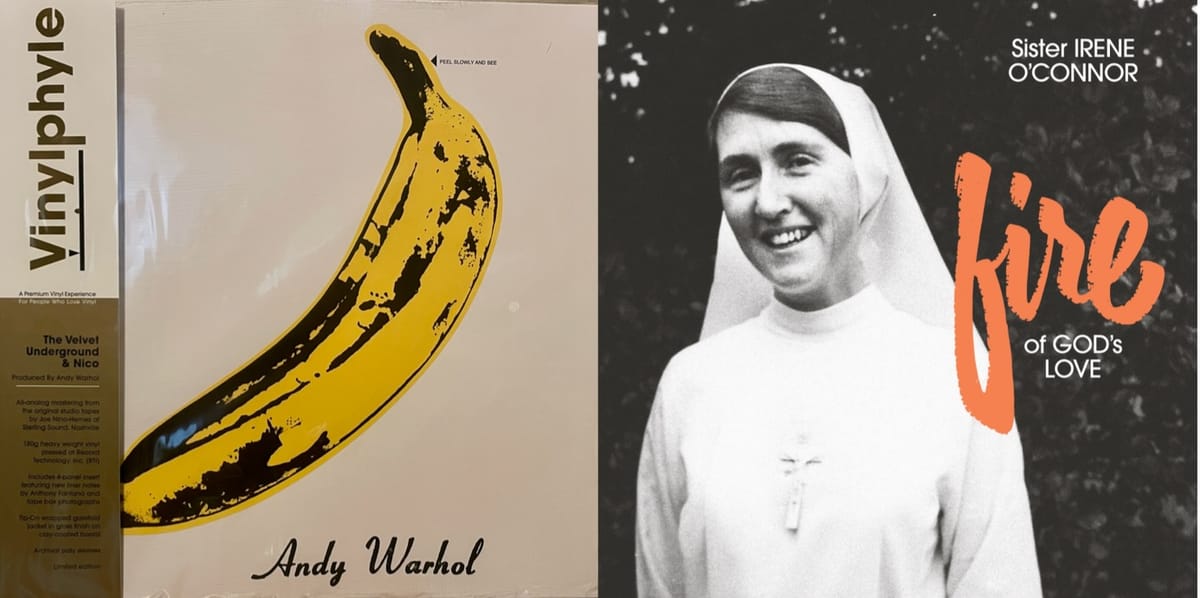
The Vinylphyle edition of The Velvet Underground & Nico, and a worthy reissue of Fire of God’s Love.
We’ve got two vinyl reviews for you today, including our first look at the ballyhooed Vinylphyle series, and a loving reissue of a gentle, inspirational oddity.
The Velvet Underground & Nico: Vinylphyle edition
Sister Irene O’Connor: Fire of God’s Love
Let’s jump right in.
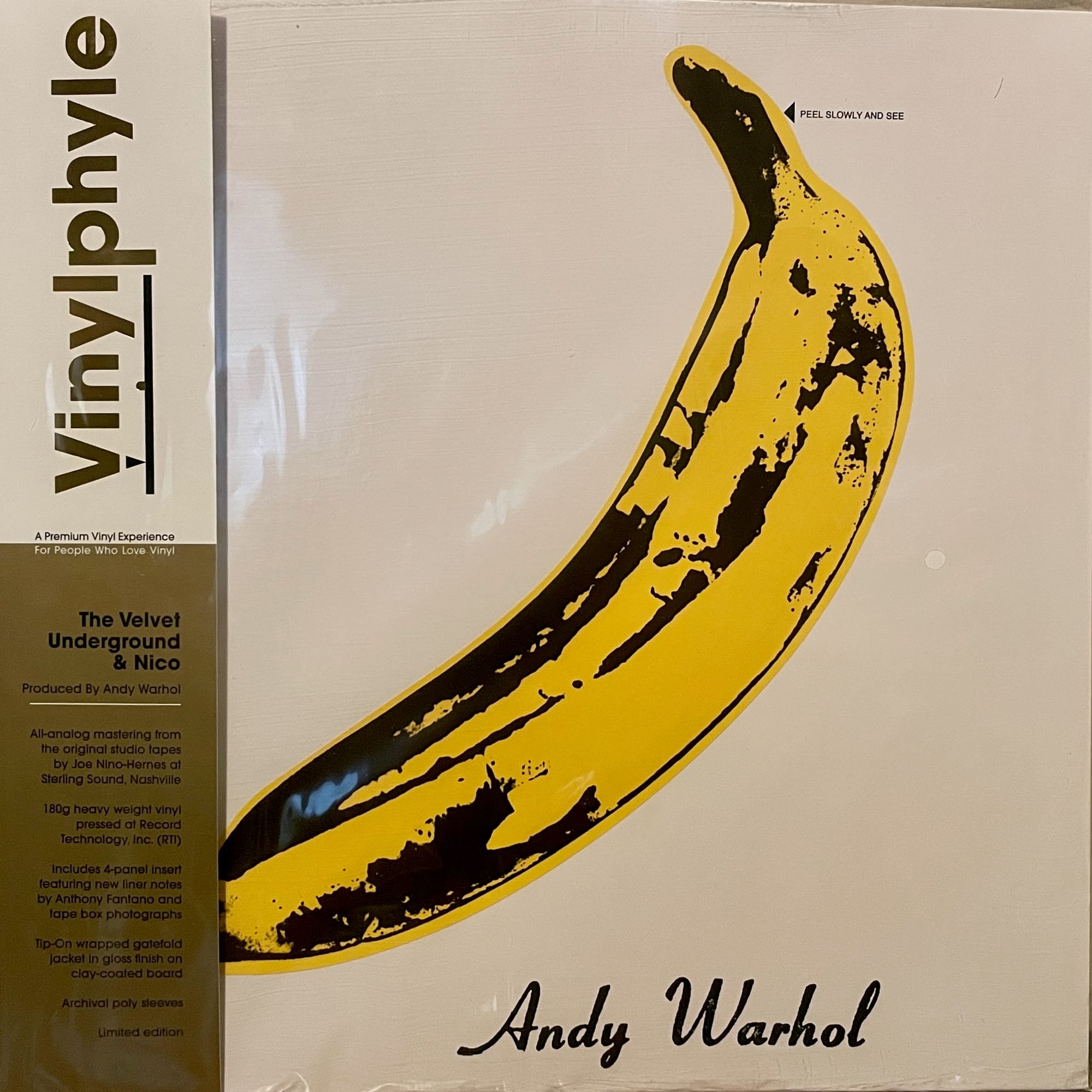
The Velvet Underground & Nico: Vinylphyle edition
Review by Ned Lannamann
With much hoopla, Universal Music Group has entered the high-end vinyl fray in recent weeks on two separate fronts. First came the October launch of their Definitive Sound Series, a high-end, high-priced, limited series of select records that feature mastering from the best available sources, premium jackets and slipcases, and one-step pressings, which removes a stage from the stamper-making process to yield a disc that’s that much closer to the master. (The latest entry in that series—a legitimately exciting all-analog two-fer of R.E.M.’s 1982 Chronic Town EP and 1983 debut album Murmur—just went on sale this morning.)
Universal’s second prong of vinyl attack was announced on November 3, and record buyers already have the first results in their hands. It’s the Vinylphyle series, a dubiously named but conceptually admirable set of reissues from Universal’s vast back catalog, featuring all-analog cuts, tip-on gatefold jackets, liner notes, and premium pressings done at Record Technology Incorporated (RTI) in Camarillo, California. In earlier editions of this newsletter, I mentioned the obvious similarities between Vinylphyle, Rhino’s High Fidelity series, and Universal’s own Blue Note Tone Poet series. To stake its own turf, Vinylphyle launched with four titles that exhibit quite a bit of range, suggesting this series has real potential for diversity: Bob Marley’s Exodus, the Band’s Northern Lights - Southern Cross, Nat King Cole’s The Christmas Song (which, go figure, is getting a simultaneous Definitive Sound Series one-step release), the Band’s Northern Lights - Southern Cross (which also got a separate 50th anniversary reissue on vinyl), and the true gotta-have-it classic of the bunch, the stereo version of Velvet Underground’s revolutionary 1967 debut, The Velvet Underground & Nico. (The mono version is considered by some to be the superior document, but such a judgment falls outside the jurisdiction of this particular review.)
So much has been said about The Velvet Underground & Nico over the past 58 years that it seems pointless to rehash any of it here. In fact, this seems to be the difficulty facing essayist Anthony Fantano of the Needle Drop, who was commissioned to write the liner notes on the four-page insert but doesn’t have a whole lot of perspective to add, other than cataloging a few of the countless musicians that were influenced by the Velvets in the years that followed. Some biographical or technical info about the making of the album would have been welcome, but it’s not to be. However, since any liner notes are good liner notes, I’ll stop complaining—especially when they’re accompanied by photos of the stereo master tape boxes, which are thrilling to see: “Sunday Morning,” a last-minute addition, is crammed with pen into an otherwise typewritten tracklist, and a helpful “NOISE & DISTORTION” warning is handily notated, as is the date, “10-25-66,” pre-dating the spliced-in addition of “Sunday Morning,” which was recorded in November. (And a very specific pox on the chud who stuck some sort of computer-printed label, complete with bar code, onto this historic artifact. What was this schmuck thinking?)
The album is a bold choice to launch an audio-forward series, because even by the standards of 1966, The Velvet Underground & Nico is not a technically pleasant-sounding recording. The album’s credited producer, Andy Warhol, had many talents, but record production was not one of them, so the band frequently sounds murky and out of tune. The guitars of Lou Reed and Sterling Morrison move along in either diesel-engine grunts or feedback-strewn shrieks, and the vocals are often poorly recorded, with harsh textures, plosives, and sibilance; “Run Run Run” and “The Black Angel’s Death Song” are two such examples, where Reed sounds like he’s singing into a cheap mic. “Femme Fatale,” too, is completely shot through with a sort of resonant distortion that sounds like someone wasn’t paying attention to the monitors on the tape machine.
But of course, it can be argued that all of this was deliberate on the part of the Velvets, who were well familiar with Warhol and the Factory crew’s sideways approach to art and were fully steeped in the sounds of avant-garde jazz and the poetry of the Beats, attitudes leavened by songwriter Reed’s fondness for big, dumb, loud New York doo-wop, R&B, and pop. Warhol’s presence was apparently a nominal one, leaving the technical stuff up to the engineers. Once Verve Records signed on, producer Tom Wilson got involved, and the songs that date from later sessions (“I’m Waiting for the Man,” “Venus in Furs,” “Heroin,” and “Sunday Morning”) are noticeably more intelligible from a sonic perspective.
And as all lo-fi appreciators know, those deliberately rough edges can lead to some cosmic sonic magic, with impossible, unearthly, and entirely non-replicable noises emitting forth from the abused technology. Magic is indeed present in The Velvet Underground & Nico’s more entrancing sounds, like the gentle guitars that traipse through “I’ll Be Your Mirror,” or the balm-like palette of “Sunday Morning,” a comedown capable of soothing the most jangled of nerves. The blend of viola, guitar, and gently malleted tom-tom on “Heroin” is narcotic in and of itself, and the chaotic drone of “All Tomorrow’s Parties”—part Reed’s “ostrich”-tuned guitar, part John Cale’s Terry Riley-style piano, part god knows what else (possibly Nico’s harmonium?)—is the sort of thing the most experienced studio rat couldn’t begin to devise deliberately.

There’s a depth and bounce in the sound of this new Vinylphyle pressing that is not present on my other vinyl copy of the stereo mix of The Velvet Underground & Nico—a 2008 cut from the “Back to Black” series that was then repressed and/or repackaged as part of the 2018 The Velvet Underground box set of their (mostly) complete studio recordings. That earlier pressing is almost certainly from some sort of digital file, and the all-analog mastering here, performed by Joe Nino-Hernes of Sterling Sound in Nashville, has it beat purely in terms of dimensionality. When I’m able to perceive the difference between analog and digital—something I’m definitely not always able to do—I often experience the difference as one of a three-dimensional soundscape versus a two-dimensional one, and on my setup I can “see” into this pressing’s stereo image like it’s a diorama, not a flat image on a screen. There is not necessarily more clarity or sharpness, but there is a realism and roundness that transports me, to a small degree, inside of the music instead of merely feeling like I’m facing it from a short ways away. Also, I should note somewhere in this review that Side 1 is more than 25 minutes long, but I did not notice any lack of dynamics or compromised sonics.
Unfortunately, there does seem to be some tape damage during the first minute or so of “Sunday Morning,” as the left channel has some high-end dropouts and intermittent fidelity loss. The end result is that Moe Tucker’s drums sound a little chewed up and Reed’s vocal wanders unnaturally across the stereo spectrum. There’s also a brief gurgling sound in the right channel during the celeste introduction. Also, my system tends to veer toward the bright side, and there are some piercing sounds on the album—namely, the numerous squalls of guitar feedback, but also the scraping of Cale’s viola and also his high-tinkling celeste on “Sunday Morning”—that were unpleasant at a healthy volume. The accentuated treble nearly, but not quite, tips Reed’s vocal on “Heroin” into sibilant territory, too; the tradeoff is that his vocal sounds more alive and present than I’ve ever heard it. I cannot crank this album without it veering into overly edgy territory, and I’m not sure if that could have been remedied. In all, I think there is a level of unvarnished accuracy that a different engineer might have chosen to mitigate with their bag of tricks, very possibly ruining the cut but perhaps also possibly elevating it to transcendence, which I think this version falls shy of. Still, this is the stereo copy of The Velvet Underground & Nico that will be my go-to, as a ’60s pressing is likely out of reach at this point and no one can agree on which ’70s or ’80s pressings are the best.
The Vinylphyle package is appealing, despite the silly name of the series appearing on the obi, which looks a little better in person than it does in the promotional images. The album comes in a glossy tip-on gatefold that replicates the original—yes, the banana is peelable, although I didn’t attempt to pull mine off. The famed torso’s there on the back cover, too. Regarding the jacket, the obi really gets into the nitty-gritty, explaining that it’s “Tip-On wrapped gatefold jacket in gloss finish on clay-coated board,” and I can just picture the guy who’s not sure he needs yet another copy of this album but is swayed by the sweet, sweet promise of clay-coated board. The interior side of the tip-on jacket is not brown or white but Vinylphyle gold; I reckon that’s the clay coat?
When I removed the disc for the first time, there was a tiny little scrap of loose vinyl inside the inner sleeve—an RTI-branded rice-paper-style poly—that dragged across Side 1 as I pulled the disc out, leaving a long but faint mark on the grooves but not affecting the sound at all, thank heavens. (Check your copy before pulling it out of the sleeve.) The four-page insert fits into the front pocket of the gatefold, and the whole thing comes in a loose reusable bag with a perforated top, a style of packaging I don’t particularly care for. My RTI-pressed vinyl was flat, centered, and perfectly pressed, with a low noise floor and one or two pops and clicks that I expect will go away after cleaning.
The familiar adage about The Velvet Underground & Nico is that everyone who bought a copy formed a band—a notion that evolved from a famous quote by Brian Eno in a May 1982 interview with the Los Angeles Times:
“I was talking to Lou Reed the other day, and he said that the first Velvet Underground record sold only 30,000 copies in its first five years. Yet, that was an enormously important record for so many people. I think everyone who bought one of those 30,000 copies started a band!” [SOURCE]
As such, the album’s real power has always been how communicable its ideas are rather than how marvelous it sounds. But for all its immediacy, this music’s enormous shadow has only grown over the decades, becoming one of the most important and iterated albums ever released. And this is, from what I can tell, the first serious treatment of it on vinyl, or at least the first one that’s been marketed that way. So whereas Mobile Fidelity and Analogue Productions steered clear, the Vinylphyle team, to their credit, leaned in—endeavoring to provide the best possible presentation of this immortal work on vinyl with the master tape in its current condition. Maybe this Vinylphyle pressing won’t sell another 30,000 copies, and maybe The Velvet Underground & Nico’s influence is fully disseminated by now, but it’s still an incredible thing to hear.
The Velvet Underground & Nico | Vinylphyle edition • Republic/Verve/Universal 1-LP 180g 33 RPM • lacquer cut from analog tape by Joe Nino-Hernes at Sterling Sound, Nashville, TN • pressed at RTI, Camarillo, CA • black vinyl
Listening equipment:
Table: Technics SL-1200MK2
Cart: Audio-Technica VM540ML
Amp: Luxman L-509X
Speakers: ADS L980
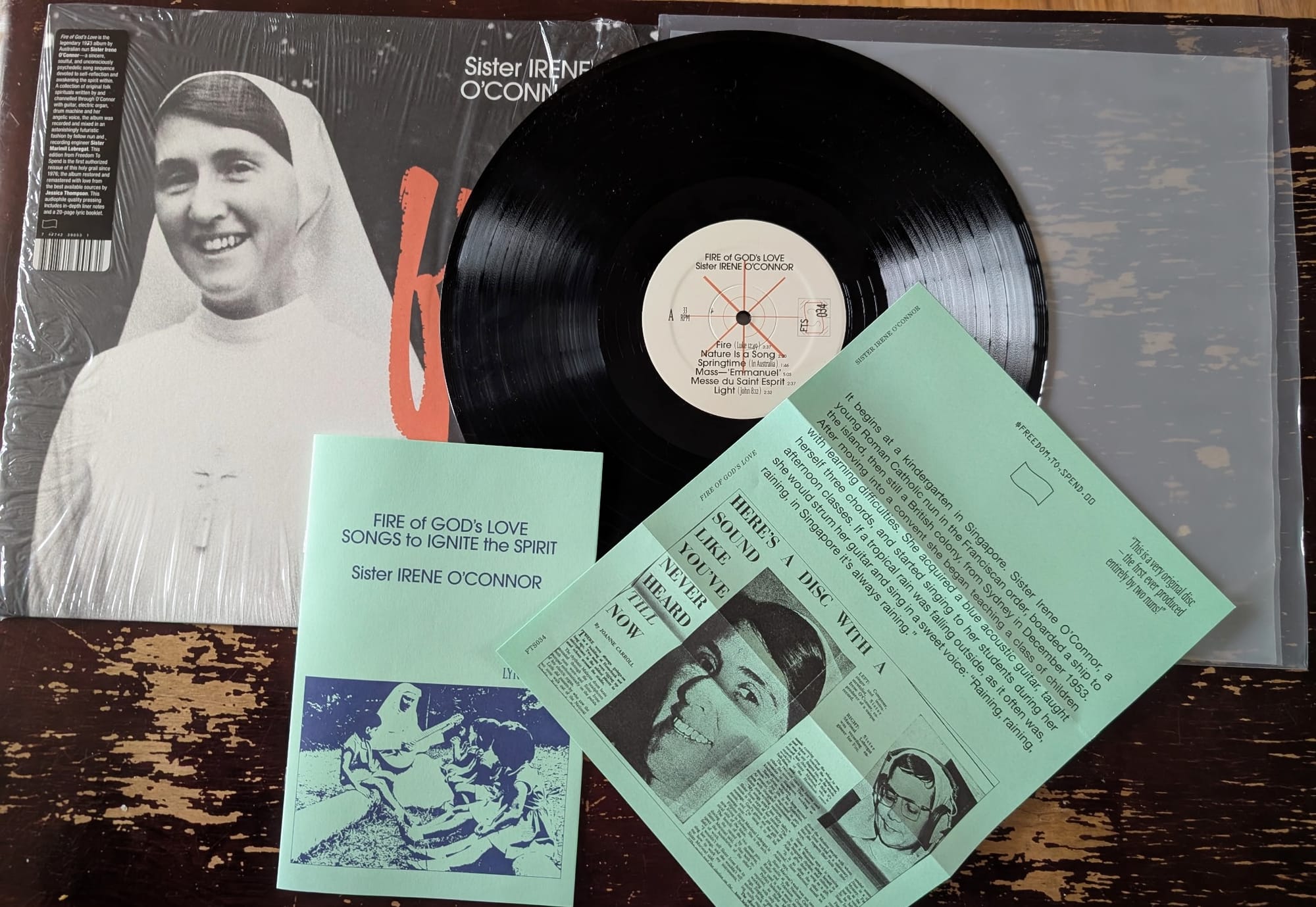
Sister Irene O’Connor: Fire of God’s Love
Review by Robert Ham
Over the course of a handful of Sundays in the early ’70s, two Franciscan nuns living in Sydney, Australia—Sister Irene O’Connor and Sister Marimal Lobregat— met up at the Catholic Radio and Television Centre to use one of the recording studios in that broadcast hub. They mic’ed up a cheap electronic organ with a built-in drum machine, figured out how to harness the resonance of the room to create natural reverb, and constructed elaborate vocal harmonies using a TEAC 3340S four-track reel-to-reel tape machine.
The pair walked out of the studio with Fire of God’s Love, an album that, even five decades later, sounds completely cut loose from time and space. Featuring lyrics built from Biblical texts and using familiar instrumentation (beyond the organ, O’Connor plays acoustic guitar and piano throughout) and folk forms, the music feels without precedent—a truly singular moment of blazing creativity and spiritual curiosity blessedly captured on tape before fading away.
First issued in Australia by Philips in 1973, the album was given a fresh pressing and a noticeable sonic upgrade by Philly-based Catholic label Alba House Communications in 1976. It is that release that helped feed the cult that surrounds Fire of God’s Love and inspired neo-psychedelic artists like Pram, Broadcast, and Grouper. That later pressing is also where independent label Freedom to Spend sourced its recently released reissue of the LP. According to Jed Bindeman, one of the three men who run the imprint, their chosen engineer Jessica Thompson restored and remastered the audio using an unplayed copy of the Alba House release, as the original master tapes have long since vanished.
The results are nothing short of astonishing. The Alba House pressing that is part of my collection sounds great on its own, with a soundstage that emphasizes the haunting reverb that carries O’Connor’s voice through each song as if buoyed by clouds. In Thompson’s careful hands, that quality remains but is joined by a deeper, richer low end. Each of the bass notes O’Connor plays with the foot pedals on her organ booms forward in an unexpectedly soothing manner. It massages at the spine and cerebral cortex, leaving listeners more open to accept these occasionally childlike paeans to faith and the mystery of an almighty creator. As much as I adore having an early copy of this album, this new pressing is superior in every way. That said, you’d do well to brace yourself for the warbling vibrato of Father Desmond O’Neil, the only guest on the album, who duets with O’Connor on “O Great Mystery (John, 6).”
The reissue of Fire of God’s Love comes at an odd time as, in most circles, it is likely to be overshadowed by the many big ticket re-releases hitting record stores in preparation for both RSD Black Friday and the holiday season. Those circumstances feel strangely fitting, though. This is a record that works best if it sneaks up on you, either dug out of a dusty box of LPs at a thrift shop or found nestled among copies of the recent reissue of the Oasis live album or the soundtrack to Pavements. Pluck this reissue out, read Aaron Coutlate’s thoughtful liner notes, and get lost in the wonders of this one-of-a-kind musical pilgrimage.
Fire of God’s Love | Freedom to Spend 1-LP 33 RPM • audio sourced from 1976 vinyl copy by Jessica Thompson at Jessica Thompson Audio in Albany, CA • lacquer cut by Clint Holley at Well Made Music in Bristol, VA • vinyl pressed at RTI, Camarillo, CA • black vinyl (fire marbled vinyl version also available)
Listening equipment:
Table: Cambridge Audio Alva ST
Cart: Grado Green3
Amp: Sansui 9090
Speakers: Electro Voice TS8-2

